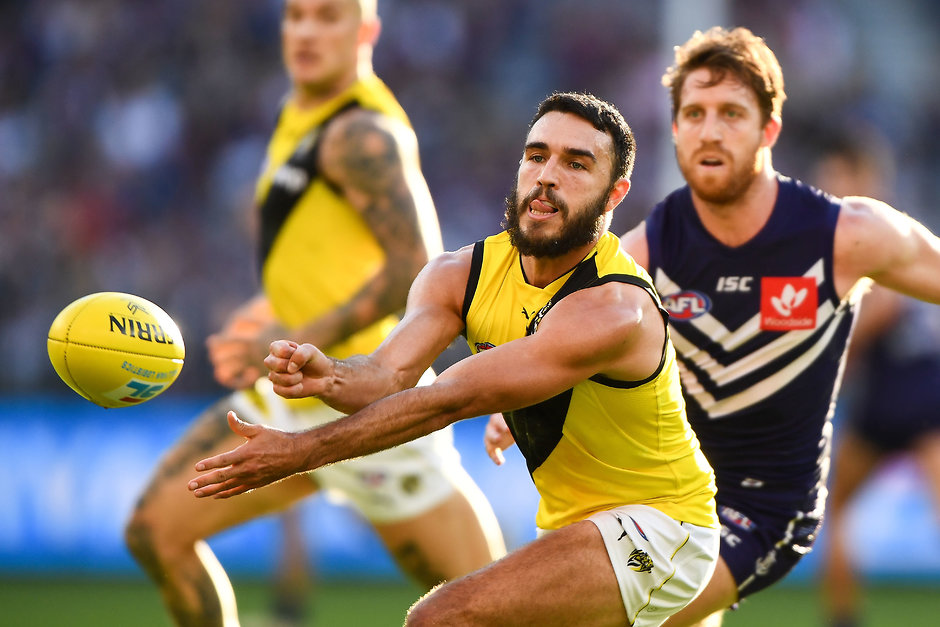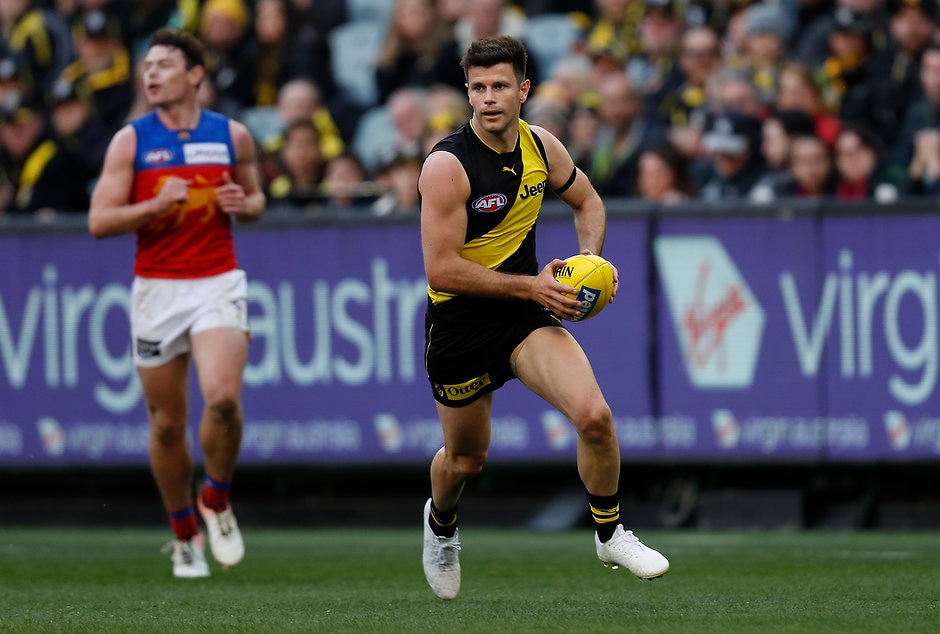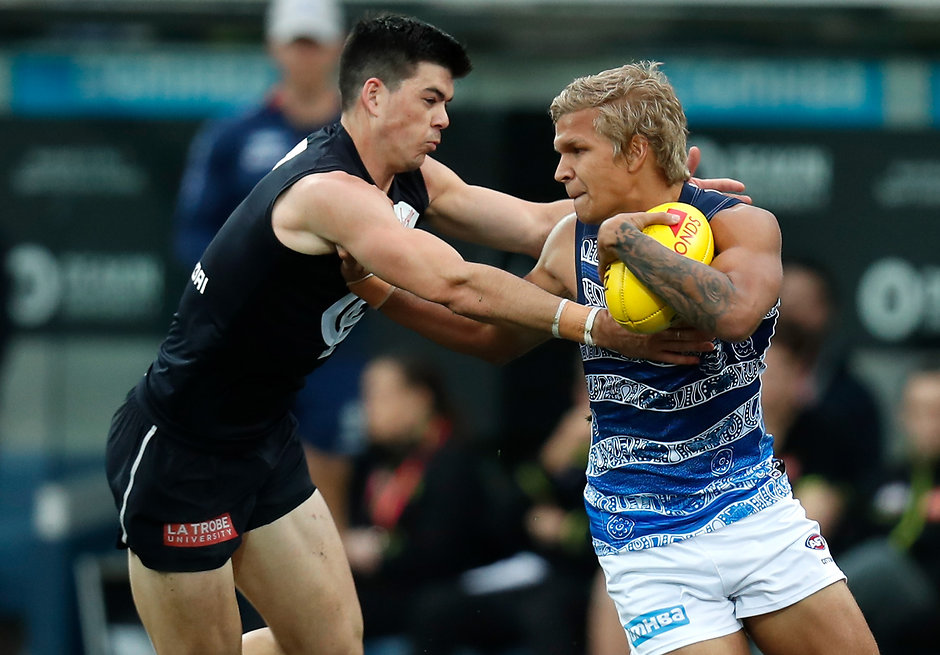NINE straight wins, including four of them over top-eight rivals Greater Western Sydney, Collingwood, West Coast and Brisbane.
There's little wonder 2017 champion Richmond sits atop this year's AFL premiership markets on finals eve.

The Tigers survived a horrific injury run to end the home and away season in third and will start September arguably in better form than their flag-winning year.
It's an ideal time to look at what's changed since that historic 2017 triumph – and what's stayed relatively the same.
The Lynch-pin in attack
Tom Lynch's arrival from Gold Coast naturally had the most dramatic effect on Richmond's playing style, giving the forward line a legitimate two-pronged target alongside Jack Riewoldt.
It was Riewoldt and a mosquito fleet two years ago, so the Tigers' ball movement this season has subsequently been longer and more direct in the forward half.
Tom Lynch and Jack Riewoldt celebrate a goal against West Coast. Picture: AFL Photos
Round 17 in their premiership year was when they 'cranked their form up to 11' and the period following that offers the best comparison of what they were doing.
Richmond used the corridor from defensive 50 just 15.5 per cent of the time from then to the Grand Final in 2017 (ranked 14th), whereas in this current streak it uses that route 20.8 per cent of the time (third).
RICHMOND'S KICK LONG %
| 2017 | 2019 (R1-14) | 2019 (R15-23) |
Forward half | 37.4% (ranked 18th) | 39.1% (ranked 13th) | 39.6% (ranked 7th) |
Defensive half | 43.4% (1st) | 40.4% (4th) | 42.3% (3rd) |
Overall | 40.3% (9th) | 39.8% (6th) | 41.0% (6th) |
The Tigers are also using the Sherrin differently in the defensive half.
Their kick-to-handball ratio of 1.09 in that area of the ground (ranked 17th) is in stark contrast to the 1.24 they operated at in the selected 2017 period (sixth).
Back then, Richmond would often kick long from defensive 50 to escape danger, and now regularly there is a more meticulous method of maintaining possession by hand on the way out.
The Richmond stat
Handball has always been a weapon in coach Damien Hardwick's arsenal.
Handball metres gained, or 'the Richmond stat', as it's become known in the competition, is where the Tigers stand out from the crowd in recent years.
THE RICHMOND STAT The number that defines Dimma's Tigers
Copycat rivals tried to replicate Richmond's attacking handball but none has mastered it to anywhere near the same level.
Shane Edwards fires out a handball against Fremantle. Picture: AFL Photos
The yellow-and-black tsunami were again comfortably No.1 in this category through the first 14 rounds this year – when they were ninth on the ladder, with a 7-6 record – and have cleared away since.
Opposition teams are also having increasing trouble sticking their tackles on the Tigers, led by fend-off ace Dustin Martin.
R1-14 | RANKING | R15-23 | RANKING | |
Handball metres gained | 459m | 1st (224m ahead) | 561m | 1st (321m ahead) |
Handball retention | 85.5% | 9th | 86.4% | 6th |
Opposition tackle efficiency | 66.5% | 17th | 60.3% | 2nd |
Still the pressure kings?
Something had to give once Lynch came into the forward line, conceivably at the expense of a smaller, more agile teammate.
The manic pressure Richmond was known for in that glorious 2017 period is still present but at a reduced rate, meaning keeping the ball in its forward half hasn't been quite as effective.
However, it's still very much a strength overall – and there has actually been improvement in some critical areas from last season.
TIGERS' FORWARD-HALF STATS
R17-GF, 2017 | RANK | 2018 | RANK | R15-23 2019 | RANK | |
Time in forward half | +8:32 | 2nd | +10:13 | 1st | +5:12 | 4th |
Points from stoppages | 20.1 | 2nd | 13.2 | 13th | 16.1 | 7th |
Points from possession gains | 42.6 | 1st | 34.8 | 1st | 36.1 | 1st |
Is Richmond better?
This is impossible to answer but the 2019 Tigers have certainly evolved.
What hasn't changed once they have close to their full complement is they are still arguably the AFL's pacesetter.
Trent Cotchin has managed just 11 games this season. Picture: AFL Photos
Intriguingly, their offensive numbers aren't quite as good as 2017, even with Lynch's inclusion, but they are League-leading.
On top of that, the defence is every bit as stingy without injured all-time great Alex Rance but the September cauldron will put that to the test.
R17-GF, 2017 | RANK | 2018 | RANK | R15-23 2019 | RANK | |
Points for | 101.2 | 1st | 95.7 | 2nd | 98 | 1st |
Points against | 63.4 | 1st | 72.3 | 2nd | 62.9 | 1st |
Disposals differential | +11.1 | 9th | -16 | 15th | +19.7 | 3rd |
Contested possession differential | +4.6 | 5th | -5.2 | 15th | +0.3 | 10th |
Uncontested possession differential | +2.5 | 10th | -13.6 | 15th | +20.2 | 3rd |
Inside 50 differential | +8.7 | 2nd | +10.2 | 2nd | +11.4 | 1st |
Points from intercepts differential | +27 | 1st | +22.9 | 1st | +25.4 | 1st |
% Total score from D50 | 7.6% | 18th | 17.5% | 8th | 20.7% | 3rd |
Goal per inside 50 % | 26.9% | 3rd | 23.4% | 11th | 25.1% | 3rd |
Your Coleman medallist
Giant Jeremy Cameron leapfrogged Ben Brown to win the Coleman Medal with a nine-goal haul against hapless Gold Coast on Saturday night.
Cameron made his move with five of those majors in the third quarter in a feat no one else has managed in any term this season.
Nine goals for Jeremy Cameron, all in under a minute! #AFLSunsGiants pic.twitter.com/IczHuXfxwJ
— AFL (@AFL) August 24, 2019
North Melbourne's Brown and Port Adelaide's Robbie Gray were the last players to achieve that in rounds nine and eight, respectively, last year – and also in third quarters.
Most scoreboard impact in a quarter in 2019
PLAYER | WHEN | TOTAL |
Jeremy Cameron | Q3, R23 | 33 points |
Kane Lambert | Q2, R2 | 25 points |
Jason Castagna | Q2, R16 | 25 points |
Tom McDonald | Q3, R19 | 25 points |
Docker dearth
Fremantle was competitive against Port Adelaide early in their round 23 encounter on Sunday, but one statistic suggested that wasn't going to last.
The Dockers managed only 32 inside 50s for the night, the fewest in the AFL this year and their least since they had 30 in round 22 last season.
Demon of a dilemma for Alex
Melbourne forward Alex Neal-Bullen had the chance to tie the scores when he gathered possession in the dying seconds against North Melbourne on Saturday.
Neal-Bullen elected to take a shot on the run from about 50m out – instead of passing the ball to Jake Melksham – but agonisingly hit the post.
It was the first time he had taken a shot from that distance on the run, but the competition expected hit rate for that kick is just 26.5 per cent, so perhaps a pass would be best next time.
But that's easy to say from here.
Narkle adding the sparkle
It took a while for Quinton Narkle to break into Geelong's senior side this year, but he's making up for lost time.
In three games since being back, Narkle ranks third for score involvements at the Cats, behind only Patrick Dangerfield and Gary Ablett, and is equal-second for clearances.

Geelong's ranked No.1 for converting clearances into scores in the past three rounds (was sixth from rounds one to 20) and has the equal-best clearance differential in that time (was 13th).
Find Trends on Apple Podcasts, Google Podcasts and Spotify


